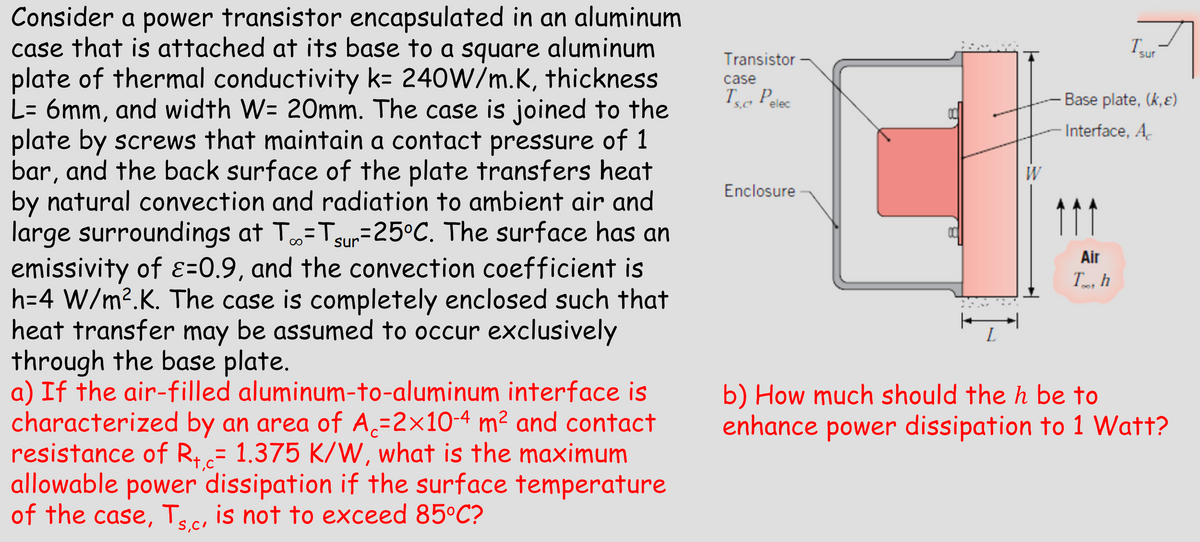Consider a power transistor encapsulated in an aluminum case that is attached at its base to a square aluminum plate of thermal conductivity k= 240W/m.K, thickness L= 6mm, and width W= 20mm. The case is joined to the plate by screws that maintain a contact pressure of 1 bar, and the back surface of the plate transfers heat by natural convection and radiation to ambient air and large surroundings at T∞ =Tsur -25°C. The surface has an emissivity of ε=0.9, and the convection coefficient is h=4 W/m².K. The case is completely enclosed such that heat transfer may be assumed to occur exclusively through the base plate. a) If the air-filled aluminum-to-aluminum interface is characterized by an area of A₁=2×10-4 m² and contact resistance of R+c= 1.375 K/W, what is the maximum allowable power dissipation if the surface temperature of the case, Ts,c, is not to exceed 85°C? S,C' Transistor case Ts. Pelec S,C' Enclosure W Isur Base plate, (k,ε) Interface, Ac Air Th 801 b) How much should the h be to enhance power dissipation to 1 Watt?
Consider a power transistor encapsulated in an aluminum case that is attached at its base to a square aluminum plate of thermal conductivity k= 240W/m.K, thickness L= 6mm, and width W= 20mm. The case is joined to the plate by screws that maintain a contact pressure of 1 bar, and the back surface of the plate transfers heat by natural convection and radiation to ambient air and large surroundings at T∞ =Tsur -25°C. The surface has an emissivity of ε=0.9, and the convection coefficient is h=4 W/m².K. The case is completely enclosed such that heat transfer may be assumed to occur exclusively through the base plate. a) If the air-filled aluminum-to-aluminum interface is characterized by an area of A₁=2×10-4 m² and contact resistance of R+c= 1.375 K/W, what is the maximum allowable power dissipation if the surface temperature of the case, Ts,c, is not to exceed 85°C? S,C' Transistor case Ts. Pelec S,C' Enclosure W Isur Base plate, (k,ε) Interface, Ac Air Th 801 b) How much should the h be to enhance power dissipation to 1 Watt?
Principles of Heat Transfer (Activate Learning with these NEW titles from Engineering!)
8th Edition
ISBN:9781305387102
Author:Kreith, Frank; Manglik, Raj M.
Publisher:Kreith, Frank; Manglik, Raj M.
Chapter2: Steady Heat Conduction
Section: Chapter Questions
Problem 2.3P: 2.3 The shield of a nuclear reactor is idealized by a large 25-cm-thick flat plate having a thermal...
Related questions
Question

Transcribed Image Text:Consider a power transistor encapsulated in an aluminum
case that is attached at its base to a square aluminum
plate of thermal conductivity k= 240W/m.K, thickness
L= 6mm, and width W= 20mm. The case is joined to the
plate by screws that maintain a contact pressure of 1
bar, and the back surface of the plate transfers heat
by natural convection and radiation to ambient air and
large surroundings at T∞ =Tsur -25°C. The surface has an
emissivity of ε=0.9, and the convection coefficient is
h=4 W/m².K. The case is completely enclosed such that
heat transfer may be assumed to occur exclusively
through the base plate.
a) If the air-filled aluminum-to-aluminum interface is
characterized by an area of A₁=2×10-4 m² and contact
resistance of R+c= 1.375 K/W, what is the maximum
allowable power dissipation if the surface temperature
of the case, Ts,c, is not to exceed 85°C?
S,C'
Transistor
case
Ts. Pelec
S,C'
Enclosure
W
Isur
Base plate, (k,ε)
Interface, Ac
Air
Th
801
b) How much should the h be to
enhance power dissipation to 1 Watt?
Expert Solution
This question has been solved!
Explore an expertly crafted, step-by-step solution for a thorough understanding of key concepts.
Step by step
Solved in 2 steps with 3 images

Recommended textbooks for you

Principles of Heat Transfer (Activate Learning wi…
Mechanical Engineering
ISBN:
9781305387102
Author:
Kreith, Frank; Manglik, Raj M.
Publisher:
Cengage Learning

Principles of Heat Transfer (Activate Learning wi…
Mechanical Engineering
ISBN:
9781305387102
Author:
Kreith, Frank; Manglik, Raj M.
Publisher:
Cengage Learning